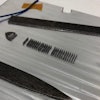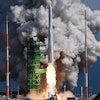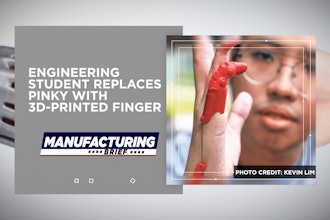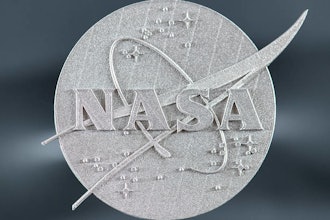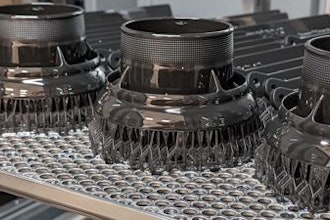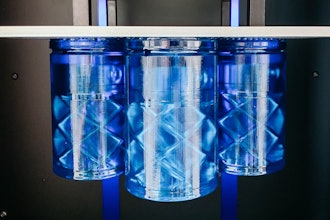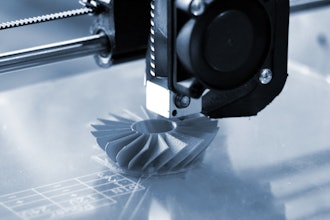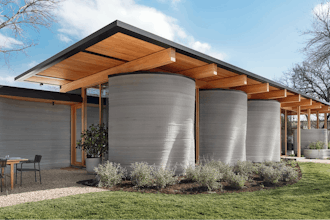
Not every material, or every shape, can withstand traveling at five times the speed of sound and faster. But in an era when hypersonic capabilities are increasingly important to the national defense strategy, two University of Arizona professors are developing new materials to 3D-print objects designed to withstand those high speeds. A $1.2 million grant from the Office of Naval Research's Defense University Research Instrumentation Program will fund a suite of new equipment to support the work and contribute to the Arizona Research Center for Hypersonics.
High Heat and High Strength
3D printing, or additive manufacturing, offers much more design flexibility than traditional manufacturing, allowing people to create precise geometries that aren't otherwise possible. It offers a new world of possibilities for the field of hypersonic flight, such as incorporating cooling pipes directly into the structure of a vehicle. To additively manufacture something, scientists or engineers make a material into a powder and print a design by melting the powder one layer at a time. Traditional manufacturing processes are a bit cruder.
"In forging, for example, you take a chunk of metal, you heat it up and you squish it into the shape you want," said Andrew Wessman, UArizona assistant professor of materials science and engineering. "If you try to take that same material, you can make it into a powder and then print with it. And it prints OK, but it's not really optimal."
Until now, most metal additive manufacturing specialists have used metal alloys that were originally developed for traditional manufacturing processes. For instance, the alloy Inconel 718, which was developed in the 1950s specifically for forging, has a mixture of elements like nickel, chrome and iron designed to give it maximum strength. But it also has some elements that cause the material, when processed via additive manufacturing, to become brittle.
Wessman and Sammy Tin, head of the Department of Materials Science and Engineering in the College of Engineering, will create novel metallic alloys optimized to be used in the additive manufacturing process and to withstand the extreme conditions of hypersonic flight, particularly at high temperatures and stress levels.
The Right Place and the Right Team
The Office of Naval Research grant will fund an array of instruments, including a powder bed fusion system to melt and fuse powders together; a gas atomization system, which allows molten liquid metal to be sprayed in ultra-fine droplets used to produce powder; a vacuum furnace for post-processing of 3D-printed objects; and an X-ray diffractometer, which can examine and characterize the inner structure of the 3D-printed objects.
"Combining all these pieces will give us a unique capability in terms of the infrastructure for advanced manufacturing," Tin said. "If we can develop materials and alloys that are specific to the 3D-printing process, we can customize alloy chemistries so that they have attributes that make it easier or more friendly for 3D printing."
Because of friction, objects traveling at hypersonic speeds experience temperatures of up to 5,000 degrees Fahrenheit. So, heat resistance is one of the most critical features of the alloys the team will develop. The materials will also need to be resistant to oxidation and other "wearing out" processes.
Together, Tin and Wessman hold over a dozen patents in alloy development. They're also in a prime location to collaborate with other experts, as UArizona is home to the Arizona Research Center for Hypersonics. Researchers in aerospace and mechanical engineering are working on projects including high-speed wind tunnel experiments and characterizing hypersonic environments. Systems and industrial engineering professor Roberto Furfaro recently received a grant from the University Consortium for Applied Hypersonics to develop improved guidance, navigation and control systems for autonomous vehicles operating at hypersonic speeds. Materials science and engineering professor Erica Corral is the university's resident expert on ultra-high temperature ceramics designed to withstand hypersonic conditions.
Ceramics are more heat-resistant than metal, so hypersonic vehicles are often coated with specialized ceramics that can withstand ultra-high temperatures. But the vehicles are made largely of metal, which is less brittle and better able to bear mechanical loads.
"Underneath the ceramic, there has to be metal," Tin said. "If we can improve the temperature capabilities of those metallic structures, that offers significant design and performance benefits."
While the team's initial work is focused on manufacturing materials for hypersonic environments, the research can also be applied to other areas, such as manufacturing of high-performance components for jet and rocket engines.
"Hypersonic flight and space exploration are among our university's biggest strengths, and both require materials that can withstand extreme environments," said University of Arizona President Robert C. Robbins. "I am proud to have faculty members like Sammy Tin and Andrew Wessman working in this critical area and raising the University of Arizona's already-impressive profile in advanced manufacturing."

